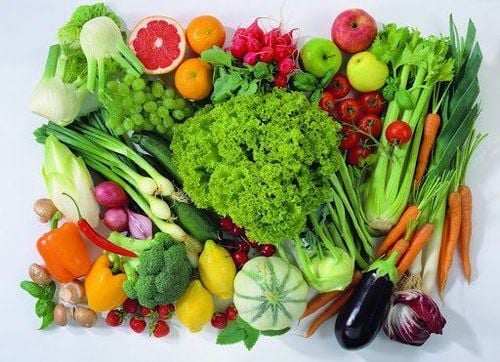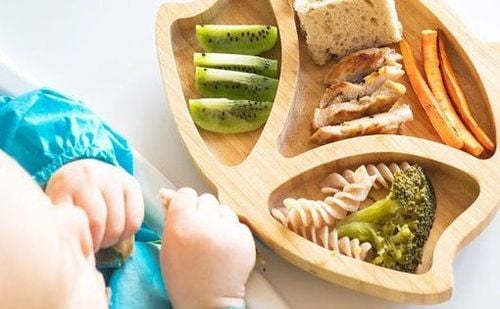This is an automatically translated article.
Normally, babies will show signs of wanting to get used to new foods from 6 months old, and 6 months old baby food plays a very important role in supplementing nutrients for the development of children. So at this time, how is it reasonable for parents to help their 6-month-old baby get used to solid foods? Read the article below about helping your baby start solids.
1. Help your 6-month-old baby get used to solid foods
1.1 When can give babies solid foods According to WHO recommendations, when the baby is 6 months old is the most appropriate time for the mother to start introducing the baby to food. Signs that your baby is ready to start solids beyond the month of age are as follows:
The baby has stiff neck, can hold his head upright The child can sit well or sit up without too much help The child Able to grasp and put objects in his mouth. Starting weaning too early or improperly eating solids will greatly affect the baby's intestinal tract. Due to the child's digestive system not being able to digest and absorb starch as well as other nutrients, it makes children prone to indigestion and digestive disorders. Over time, it can cause children to have a fear of eating, anorexia, leading to slow growth, not gaining weight and more dangerously malnutrition. In addition, sensitive children are more likely to have food allergies.
There are 3 popular weaning methods for mothers to choose from: Traditional weaning; BLW weaning ; Japanese style weaning. Each method has its own advantages and disadvantages, so you need to consider your family situation and work to choose the right method for your child.
1.2 Principles to be followed when introducing a 6-month-old baby to solids End at the right time: During the feeding process, the mother should not force the child to eat all of the child's food. Do not feed the child when the child is not really hungry, and should stop when the child has shown signs of fullness. In addition, each meal should only last for 30 minutes, if during that time, the child refuses to cooperate, the mother should also stop the meal when 30 minutes have passed and give the child more food next time. Give your baby foods from liquid to solid: Because before that, babies only eat breast milk or formula, so when getting them used to solid foods, mothers should also give them time to gradually adapt to the changes. new. The food prepared for children must be soft, easy to chew, and easy to swallow because the child has not yet developed teeth or has very few teeth. For the first meal, the mother should only give the child a few spoonfuls, after a while, the child will gradually get used to it, gradually increase the amount of food. In addition, the baby's stomach cannot hold too much food and the digestive system has not had time to adapt. Feed children a variety of food groups: Balance between groups of carbohydrates - proteins - fats - vitamins and minerals to help fully supplement essential nutrients for the best development of children. Foods must be clean, sourced, and hygienically processed so as not to affect the child's immature digestive system. Add a little cooking oil when cooking for children to help dissolve vitamins A, vitamin D, vitamin E, vitamin K and other substances for easy absorption by the body. Do not suck the child's spoon when feeding the child accidentally, it will infect some respiratory diseases for the child.

Bé ăn dặm 6 tháng cần được làm quen với thức ăn
1.3 Nutrient Notes to Remember In addition to continuing to feed your baby 2-3 times, keep in mind the following information about some key nutrients: Iron, protein, calcium, DHA, folate and choline; Why are they important and what foods can they be found in?
Iron is important for preventing iron deficiency anemia, which can affect growth and development if left untreated. Iron is an important component of red blood cells and is found most often in meat products, although it can also be found in foods such as oatmeal or fortified cereals, beans and peas. puree and spinach. Calcium is important for bone and tooth health, blood clotting, nerve communication, hormones, muscle contraction, and other processes. Good sources of calcium for your new baby include: Breast milk, infant formula, yogurt; pureed greens like kale, bok choy, and spinach, as well as pureed beans. DHA is important for brain development and healthy growth. DHA is an omega 3 unsaturated fat that can be found in oily fish (salmon, sardines, rainbow trout), breast milk, infant formula and fortified foods. other. Choline is important for cell function and supports brain health. For your baby just starting on solids, pureed cabbage, spinach, cauliflower and beans are good sources of choline. Shredded spinach and bok choy work best when paired with a few other foods (apples, oats, avocados), then you can give them soft cooked and chopped when they're ready to be done. structures. Protein is an important component of our skin, hair, nails, muscles, blood, and bones. Breast milk and formula are rich sources of protein. In addition, there are other foods such as: Yogurt; pureed beans, pureed tofu, and quinoa.
2. Weaning menu for 6-month-old baby is attractive and easy to absorb
2.1 How to prepare food for each weaning diet Traditional weaning: Starting with flour or porridge mixed with the same vegetables and tubers that have been boiled and pureed, the baby's powder is only slightly thicker than breast milk. A little bit for children to gradually get used to Japanese-style weaning: The first food is porridge or diluted powder with a ratio of 1: 10 (1 part porridge 10 parts water) or steamed tubers and fruits and then pureed and mixed with dashi water. Baby-led weaning: Food for children should be cut to the length of about 2 adult fingers and steamed or boiled, but be careful not to be too soft for children to grasp. All foods prepared for babies at this stage with any weaning method are not seasoned with fish sauce, salt or any other seasoning.

Bé ăn dặm 6 tháng cần được chế biến đúng cách
2.2 Foods that are not good for children With a weaning menu full of diverse food groups, especially tubers and fruits, mothers should feed their children fully according to the color of the rainbow. If your child does not like a certain food, do not rush to remove it from the menu, but add them to their meals from time to time, but remember not to force them to eat them.
However, not all foods can be eaten by babies. Here are some foods that are recommended by nutritionists not to be used for children :
Honey : Completely contraindicated for children under 1 year old Salt and products containing a lot of salt Sugar and water sweets, bottled water, confectionery... Fresh milk, peanuts, eggs Small round particles can cause choking. 2.3 Menu for 6-month-old baby food A - Traditional weaning
6 am: Breastfeeding or formula feeding about 150ml - 200ml 9 am: Feed baby powder (or porridge) with other recipes Each other: Pork meal, chicken meal, milk powder, egg powder 10 hours snack: Can use fruits: 1/3 banana, 50g ripe papaya, 1/3 sapodilla, 50g mango 12 noon a milk meal: Breast milk or formula – 150 ml 14 pm: Light snack of mashed butter, yogurt 16 pm: Powdered meal, can choose milk powder, pork meal, chicken meal 19 hours Evening: One feeding is about 150ml - 200ml
B - Weaning baby leader (BLW)
Vegetables (Carrots, chayote, beans, peas, radishes, broccoli, sweet potatoes...) steamed until tender Boiled chicken: chicken after being cleaned is boiled/steamed until finely chopped. Butter: Cut an avocado into 4-6 lengths for children to hold and eat Egg yolks: Fry or boil and then feed your baby with a spoon/fork Fruit: Banana, blueberry, apple, strawberry, avocado....
3. Common problems when feeding 6-month-old babies
3.1 Food Allergies When you give your child any kind of food, pay attention to the signs of food allergy: Diarrhea, vomiting, rash, sudden stomach upset...
Usually the Allergenic foods for children such as: Soy, peanuts, wheat, nuts... Respect for the principle of food allergy testing is to let your child eat less and eat continuously for at least 2 days. .
Besides, food intolerance is also a top concern in young children, even more common than food allergies, causing symptoms such as gas and bloating.
If your child is at high risk for a food allergy or intolerance, you should consult a specialist to carefully review which foods are safe for your baby.
3.2 Children with colic Most children have bloating or vomiting because they eat too much or swallow a lot of air during eating or food is not suitable for their digestion. Mothers can handle this situation by balancing the amount of food provided to the baby, burping properly after the baby drinks or sucks milk.
If the child does not defecate for 1-2 days but still eats well, sleeps well, plays well, then the mother does not have to worry too much, it is just that the child does not have the need to go.

Bé ăn dặm 6 tháng có thể gặp tình trạng đau bụng
3.3 Constipated children Children who have just started eating solid foods often have the following symptoms of constipation: Long bowel movements, hard abdomen, bloating, anorexia, fussy stools, hard stools. The cause may be that the child's digestive system has not yet adapted to the change of consuming foods other than milk. Or another reason is because of the mother's processing, the food for the child is too thick and low in fiber. The mother can overcome it by adjusting the recipe, making it thinner and adding more vegetables; Rub the abdomen to make it easier for the child to defecate.
3.4 Choking or crying when eating These are completely normal phenomena in babies just starting solid foods. The main cause is that children are gradually practicing swallowing reflex, the reflex to close the larynx when eating has not been completed, so it is easy to choke. To overcome it, the mother gives the child a little food, a smaller piece, sitting at the place to eat. , use spoons, drinking cups appropriate for the child's age. If the child chokes on liquid food, use safe suction devices to suck up the remaining food in the mouth and nose to clear the airway. At the same time, it does not cause stagnation, which is dangerous for the digestive system. In the case of children choking due to solid food, it is necessary to calmly give first aid without touching the child's throat, which will cause food to go deeper, causing difficulties for children. handling.
In addition, in the baby's weaning diet, it is necessary to add the necessary micronutrients: Zinc, selenium, chromium, vitamins B1 and B6, ginger, acerola fruit extract (vitamin C),... to improve taste. , eat well, reach the right height and weight, and exceed the standard, have a good immune system, strengthen the resistance to get sick less often and have less digestive problems.
Also according to leading nutrition experts, parents need to be calm and persistent when supplementing with nutrients for children, even through eating or functional foods. In particular, the use of functional foods should choose those of natural origin that are easily absorbed, do not allow simultaneous use of many types or continuously change the types of functional foods. Besides, nutritionists also emphasize on the role of biological zinc; Parents should learn and supplement zinc for children properly at the appropriate time, to avoid zinc deficiency affecting the comprehensive development of children.
In addition to zinc, parents also need to supplement their children with other important vitamins and minerals such as lysine, chromium, B vitamins,... errands.
To have more knowledge of raising healthy children, parents should proactively update useful medical information on Vinmec.com website and immediately contact doctors and experts at Vinmec when needing support.













